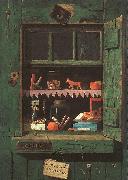Wholesale Oil Painting No Minimum |
|||||||||||
|
|
|||||||||||

|
|||||||||||
|
|
|
||||||||
John Frederick Peto1854-1907 John Frederick Peto Gallery John Frederick Peto (May 21, 1854 ?C November 23, 1907) was an American trompe l'oeil ("fool the eye") painter who was long forgotten until his paintings were rediscovered along with those of fellow trompe l'oeil artist William Harnett. Although Peto and the slightly older Harnett knew each other and painted similar subjects, their careers followed different paths. Peto was born in Philadelphia, Pennsylvania, and studied at the Pennsylvania Academy of the Fine Arts at the same time as Harnett.[1] Until he was in his mid-thirties, he submitted paintings regularly to the annual exhibitions at the Philadelphia Academy. In 1889, he moved to the resort town of Island Heights, New Jersey, where he worked in obscurity for the rest of his life. He and his wife took in seasonal boarders, he found work playing cornet at the town's camp revival meetings, and he supplemented his income by selling his paintings to tourists.[2] He never had a gallery exhibition in his lifetime.[3] Harnett, on the other hand, achieved success and had considerable influence on other artists painting in the trompe l'oeil genre, but even his paintings were given the snub by critics as mere novelty and trickery. Both artists were masters of trompe l'oeil, a genre of still life that aims to deceive the viewer into mistaking painted objects for reality. Exploiting the fallibility of human perception, the trompe l'oeil painter depicts objects in accordance with a set of rules unique to the genre. For example, Peto and Harnett both represented the objects in their paintings at their actual size, and the objects rarely were cut off by the edge of the painting, as this would allow a visual cue to the viewer that the depiction was not real. But the main technical device was to arrange the subject matter in a shallow space, using the shadow of the objects to suggest depth without the eye seeing actual depth. Thus the term trompe l'oeil??"fool the eye." Both artists enthrall the viewer with a disturbing but pleasant sense of confusion. Letter Rack by PetoPeto's paintings, generally considered less technically skilled than Harnett's,[4] are more abstract, use more unusual color, and often have a stronger emotional resonance. Peto's mature works have an opaque and powdery texture which is often compared to Chardin.[5] The subject matter of Peto's paintings consisted of the most ordinary of things: pistols, horseshoes, bits of paper, keys, books, and the like. He frequently painted old time "letter racks," which were a kind of board that used ribbons tacked into a square that held notes, letters, pencils, and photographs. Many of Peto's paintings reinterpret themes Harnett had painted earlier,[6] but Peto's compositions are less formal and his objects are typically rustier, more worn, less expensive looking.[7] Other artists who practiced trompe l'oeil in the late nineteenth century include John Haberle and Jefferson David Chalfant. Otis Kaye followed several decades later. A pioneering study of Peto and Harnett is Alfred Frankenstein's After the Hunt, William Harnett and Other American Still Life Painters 1870-1900. Frankenstein's book itself is a fantastic tale of solving the mystery of why these artists were forgotten for much of the twentieth century. |
||||||||
|
|
||||||||
The Poor Man s Store
The Poor Man s Store Painting ID:: 4278 |
1885
Museum of Fine Arts, Boston 1885 Museum of Fine Arts, Boston |
|||||||
|
|
||||||||
|
Peto, John Frederick American, 1854-1907 American painter. He trained at the Pennsylvania Academy of Fine Arts (1877-8), Philadelphia, where he became a friend of William Michael Harnett whose work was a dominant influence on his oeuvre. Peto maintained a studio in Philadelphia, exhibiting at the Academy from 1879 to 1887; he earned a living through occasional work as a photographer, sculptor and painter. After moving to Island Heights, NJ, in 1889, The Poor Man s Store 1885 Oil on canvas and wood Museum of Fine Arts, Boston |
||||||||
|
|
||||||||
|
Prev Next
|
||||||||
|
|
||||||||
|
Related Paintings to Peto, John Frederick :. |
||||||||
|
|
||||||||
|
CONTACT US |

